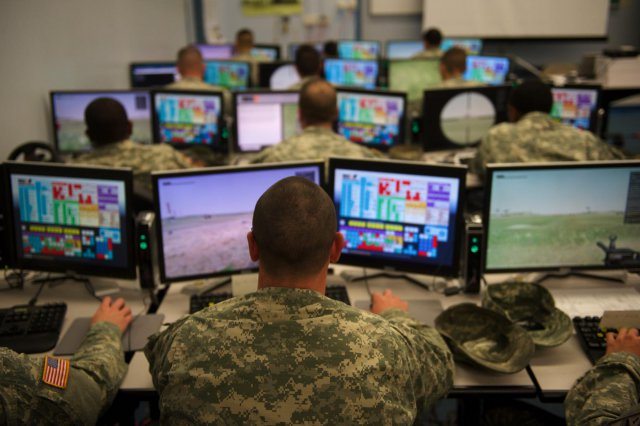In an effort to further develop and enhance ‘Force 2025′ capabilities, U.S. Army Training and Doctrine Command’s Army Capabilities Integration Center held a pilot test for Early Synthetic Prototyping here, Monday through Thursday.
The Early Synthetic Prototyping, or ESP, uses a virtual environment to allow Soldiers the ability to assess and give feedback on emerging technologies; essentially guiding science and technology research, and doctrine, organization and training development, in a more fiscally responsible manner.
“The goal of [ESP] is to incorporate Soldiers’ insight earlier in the development process — where design changes are inexpensive — and find out what works and doesn’t work,” said Lt. Col. Brian D. Vogt, the Army Capabilities Integration Center’s Army simulations operations officer. “We want to make the acquisition process faster, to better meet the needs of the future operation environment.”
The pilot test introduced Soldiers from 2nd Brigade Combat Team, 1st Armored Division, to Bohemia Interactive’s online game, Virtual Battle Space 3. The game provided the platform for “Old Ironsides” Soldiers to assess everything from conceptual weapon systems, to the game’s user interface and playability, giving Soldiers the opportunity to shape the future and adapt to new threats through a new form of training.
“I think it’s great that they’ve asked the lowest ranking Soldiers to test out what could possibly be the future of the Army’s technological advances,” said Pfc. Mathew Giesey, 4th Battalion, 27th Field Artillery. “To know they’ve entrusted us to come here and be a part of this test and take it as seriously as they do, it means a lot.”
Gen. David G. Perkins, TRADOC commanding general, said it is important for future force development to have Soldiers become part of the materiel and concept development process early on.
“From the materiel aspect of it — when we buy stuff for the Army, how we organize ourselves, and how we apply all the elements of national power — we have to enable young leaders through training, education and organization to have the ability to innovate very quickly,” Perkins said.
Vogt added that the assessments made through Virtual Battle Space 3 will be used to refine the development of the synthetic environment and provide a solid foundation for a future online training; contributing to Army-wide ESP, and allowing engineers and concept developers to be more efficient and effective in modeling multiple potential capabilities and prototypes for future use in the Army.
“We have found that Soldiers are excited about participating in the future of their Army,” Vogt concluded. “When Soldiers eventually see this equipment arrive in their motor pool or in their arms room, it will have their fingerprints all over it. They will know that this has been fleshed out — by real Soldiers — at the early stages.”











